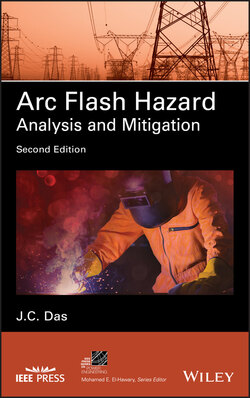Читать книгу Arc Flash Hazard Analysis and Mitigation - J. C. Das - Страница 47
REFERENCES
Оглавление1 W.A. Brown and R. Shapiro, “Incident energy reduction techniques,” IEEE Industry Applications Magazine, vol. 15, no. 3, pp. 53–61, May/June 2009.
2 T. Gammon and J. Mathews, “Conventional and recommended arc power and energy calculations and arc damage assessment,” IEEE Trans. Ind. Appl., vol. 39, no. 3, pp. 197–203, May/June 2003.
3 T. Gammon and J. Mathews, “Instantaneous arcing fault models developed for building system analysis,” IEEE Trans. Ind. Appl., vol. 37, no. 1, pp. 197–203, Jan./Feb. 2001.
4 V.V. Terzija and H.J. Koglin, “On the modeling of long arc in still air and arc resistance calculations,” IEEE Trans. Power Deliv., vol. 19, no. 3, pp. 1012–1017, July 2004.
5 A.D. Stokes and D.K. Sweeting, “Electrical arcing burn hazards,” IEEE Trans. Ind. Appl., vol. 42, no. 1, pp. 134–142, Jan./Feb. 2006.
6 H.B. Land, III, “Determination of the case of arcing faults in low-voltage switchboards,” IEEE Trans. Ind. Appl., vol. 44, no. 2, pp. 430–436, March/April 2008.
7 H.B. Land, III, “The behavior of arcing faults in low-voltage switchboards,” IEEE Trans. Ind. Appl., vol. 44, no. 2, pp. 437–444, March/April 2008.
8 R. Wilkins, M. Allison, and M. Lang, “Effects of electrode orientation in arc flash testing,” in Proc. IEEE IAS Annual Meeting, Hong Kong, pp. 459–465, 2005.
9 IEEE 1584, IEEE Guide for Performing Arc-Flash Hazard Calculations, 2002.
10 J.C. Das, “Arc flash hazard,” in McGraw-Hill Year Book of Science and Technology, pp. 18–20, McGraw-Hill, New York, 2008.
11 R. Lee, “The other electrical hazard: Electrical arc blast burns,” IEEE Trans. Ind. Appl., vol. 1A-18, no. 3, pp. 246–251, May/June 1982.
12 R. Lee, “Pressure developed by arcs,” IEEE Trans. Ind. Appl., vol. IA-23, no. 4, pp. 760–764, July/Aug. 1987.
13 R.L. Doughty, T.E. Neal, T.A. Dear, and A.H. Bingham, “Testing Update on Protective Clothing and equipment for arc exposure,” IEEE Industry Applications Magazine, vol. 5, no. 1, 37–49, Jan./Feb. 1999.
14 R.L. Doughty, T.E. Neal, and H.L. Floyd, II, “Predicting incident energy to better manage the electric arc hazard on 600-V power distribution systems,” IEEE Trans. Ind. Appl., vol. 36, no. 1, pp. 257–269, Jan./Feb. 2000.
15 R.A. Jones, D.P. Liggett, M. Capelli-Schellpfeffer, T. Macalady, L.F. Saunders, R.E. Downey, L.B. McClung, A. Smith, S. Jamil, and V.J. Saporita, “Staged tests to increase awareness of arc-flash hazards in electrical equipment,” IEEE Trans. Ind. Appl., vol. 36, no. 2, pp. 659–667, March/April 2000.
16 R. Wilkins, M. Lang, and M. Allison, “Effect of insulating barriers in arc flash testing,” in conf. record, IEEE Pulp and Paper Industry Technical Conf. pp. 120–125, Seattle, 2008.
17 NFPA 70E, Electrical Safety in Workplace, 2012.
18 M.G. Drouet and F. Nadeau, “Pressure waves due to arcing faults in a substation,” IEEE Trans. PAS, vol. PAS-98, no. 5, pp. 1632–1635, Sep. 1979.
19 M. Wactor, G.H. Miller, J. Bowen, and M. Capelli-Schellpfeffer, “Modeling of pressure wave associated with arc fault,” IEEE PCIC conf. Rec., pp. 333–341, Sept. 2000.
20 T.E. Neal and R.E. Parry, “Sharpnel, pressure and noise,” IEEE Industry Applications Magazine, vol. 11, no. 3, 49–54, June 2005.
21 IEEE Std. 80, Safety in AC Substation Grounding, 2000.
22 L.A. Geddes and L.E. Baker, “Response of passage of electrical current through the body,” J. Assoc. Adv. Med. Instrum., vol. 2, pp. 13–18, Feb. 1971.
23 IEC 604791-1, Effect of Current on Human Beings and Livestock Part 1: General Aspects, 2005.
24 C.F. Dalziel, J.B. Lagen, and J.L. Thruston, “Electrical shock,” AIEEE Trans. PAS, vol. 60, pp. 1073–1079, 1941.
25 C.F. Dalziel and R.W. Lee, “Lethal electric currents,” IEEE Spectrum, pp. 44–50, Feb. 1969.
26 L.P. Fewrris, B.G. King, P.W. Spence, and H. Williams, “Effect of electrical shock on the Heart,” AIEEE Trans. PAS, vol. 55, pp. 498–515 and 1263, May 1936.
27 U.G. Biegelmeier and W.R. Lee, “New considerations on the threshold of ventricular fibrillation for AC shocks at 50–60 Hz,” Proc. IEEE, vol. 127, pp. 103–110, 1980.
28 W.B. Kouwenhoven, et al., “AC shocks of varying parameters affecting the heart,” AIEEE Trans. PAS, vol. 78, part 1, pp. 163–169, 1959.
29 D. Roberts, “50-V shock hazard threshold,” IEEE Trans. Ind. Appl., vol. 46, no. 1, pp. 102–107, Jan./Feb. 2010.
30 Society of Fire Protection Engineers (SPFE) Task Force, Engineering Guide to Predicting First and Second Degree Skin Burns, Boston, MA, 2000.
31 NFPA 921, Guide for Fire and Explosion Investigations, 2011.
32 ANSI/IEEE C2, National Electric Safety Code, 2007.
33 IEEE 1584a, IEEE Guide for Performing Arc-Flash Hazard Calculations—Amendment 1, 2004.
34 IEEE P1584b/D2, Draft 2, Guide for Performing Arc Flash Hazard Calculations—Amendment, July 2009 (unapproved).
35 ASTM F1506, Specifications for Textile Materials for Wearing Apparel for Use by Electrical Workers Exposed to Momentary Electrical Arc and Related Thermal Hazards, 1998.
36 J.C. Das, “Design aspects of industrial distribution systems to limit arc flash hazard: Part II-Analysis,” IEEE Trans. Ind. Appl., vol. 41, no. 6, pp. 1467–1482, Nov./Dec. 2005.
37 J.C. Cawley and T. Homce, “Trends in electrical injury in the U.S., 1992–2002,” IEEE Transactions on Industry Applications, vol. 44, no. 4, pp. 962–972, July/August 2008.
38 J.C. Cawley and B.C. Brenner, “Occupational electrical injuries in the U.S., 2003–2009,” IEEE Paper No. ESW-2012-24, 2012.
